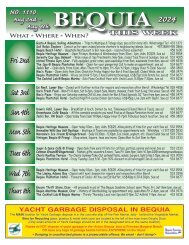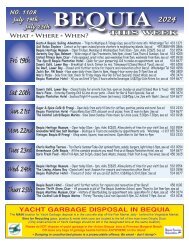Caribbean Compass Yachting Magazine - November 2020
Welcome to Caribbean Compass, the most widely-read boating publication in the Caribbean! THE MOST NEWS YOU CAN USE - feature articles on cruising destinations, regattas, environment, events...
Welcome to Caribbean Compass, the most widely-read boating publication in the Caribbean! THE MOST NEWS YOU CAN USE - feature articles on cruising destinations, regattas, environment, events...
Create successful ePaper yourself
Turn your PDF publications into a flip-book with our unique Google optimized e-Paper software.
The Sky from<br />
Mid-<strong>November</strong> to<br />
Mid-December<br />
by Jim Ulik<br />
THE CARIBBEAN SKY: FREE SHOW NIGHTLY!<br />
KARL JAUSLIN AND ADOLF VOLLMY<br />
NOVEMBER <strong>2020</strong> CARIBBEAN COMPASS PAGE 18<br />
It was known to ancient Greeks that the Earth was a sphere. Technically, the Earth<br />
is a spheroid because it is not a perfect sphere. After thousands of years of<br />
calculations confirming this fact, 18 to 25 percent of the people surveyed in our<br />
modern world still believe Earth is flat. One third of millennials (anyone born<br />
between 1981 and 1996) maintain that belief. Geez! Some also do not believe in<br />
gravity. A spinning flat Earth gives the illusion of gravity. Does that mean falling<br />
stars are literally stars dropping out of the sky?<br />
As it turns out the Earth both rotates east and orbits in an easterly direction. That<br />
is, of course, based upon the observations from any given location on Earth. This<br />
rotational and orbital momentum plays a part in the speed of meteors reaching<br />
Earth. Earth’s orbit takes our planet into a few streams of high concentrations of<br />
debris left behind from comets and asteroids this period.<br />
Tuesday, <strong>November</strong> 17th<br />
First observed in 1366 and later “discovered” in 1865, comet 55P/Tempel-Tuttle<br />
was found to have an orbital period of 33 years. The last time the comet made a close<br />
pass to Earth was in 1998. Earth began its current pass through this comet’s debris<br />
field on <strong>November</strong> 6th. The peak stream of debris will be reached overnight. Shooting<br />
stars will become observable radiating out of the east after midnight. The Leonids<br />
meteor shower may produce up to 20 meteors per hour. The shower will be active<br />
through <strong>November</strong> 30th. The speed of Earth through space plus its rotational speed<br />
makes these meteors collide with our atmosphere at a very fast rate of speed.<br />
Wednesday, <strong>November</strong> 18th – Thursday, <strong>November</strong> 19th<br />
The Moon is now a waxing crescent or halfway between its new and first quarter<br />
phase. Low in the southwestern sky over the next two days the Moon will appear to<br />
take up residence near Saturn and Jupiter. On the 18th it will be positioned below<br />
Jupiter in Sagittarius. By the 19th the Moon will have exited the half-man, halfhorse<br />
constellation and be positioned above Saturn.<br />
Saturday, <strong>November</strong> 21st<br />
Earth has intercepted another debris field, generating another meteor shower. The<br />
radiant of the Monocerotids originates from an area in the constellation of Monoceros<br />
the unicorn. Petrus Plancius created this constellation around 1612 to fill the gap<br />
between Orion and Hydra. Because this constellation is relatively dim, the radiant is<br />
easier to locate near Canis Minor. To spot any shooting stars look out just before<br />
midnight at least 45 degrees away from the radiant of the shower. This variable<br />
shower peaks tonight producing from five to 400 meteors per hour.<br />
The Alpha Monocerotids celebrates some anniversaries today. In 1925 (95th<br />
anniversary) and 1935 (85th anniversary) the Alpha Monocerotids produced about 1,000<br />
meteors per hour. In 1985, 700 shooting stars per hour burned up in the atmosphere.<br />
During the 1995 shower about 400 meteors per hour radiated through the sky.<br />
Wednesday, <strong>November</strong> 25th<br />
There are two twosomes overhead in the night sky. The waxing gibbous Moon will<br />
rendezvous with Mars throughout the night. Look for the pair to reach their highest<br />
point in the sky around 2045 hours. Another pair in apparent close proximity is Jupiter<br />
and Saturn. They can be found sinking in the western sky finally setting around 2100.<br />
Saturday, <strong>November</strong> 28th<br />
As noted in last month’s article, it was the beginning of another solar cycle that<br />
signifies increased sunspot activity. Sunspots affect many aspects of life on Earth.<br />
What would life be like without GPS? Maybe a welcome break in social networking<br />
A 19th century woodcut with an impression of the spectacular <strong>November</strong> 13th,<br />
1833 Leonid storm.<br />
wouldn’t be so bad. In the 1850s amateur astronomer Lord Richard Carrington<br />
determined the solar rotation rate by watching sunspots. The significance of the<br />
sunspot activity became apparent when Lord Carrington witnessed a massive solar<br />
flare in 1859. The Carrington Event of 1859 sparked major aurora displays visible<br />
as far south as the <strong>Caribbean</strong>. It also caused severe interruptions in global telegraph<br />
communications, even shocking some telegraph operators and sparking fires when<br />
discharges from the lines ignited telegraph paper. From being concerned principally<br />
with charting the stars to aid navigation, astronomers became increasingly<br />
concerned with what the celestial objects were, how they behaved and how they<br />
might affect life on Earth. The Sun’s rotation has been recorded since 1853.<br />
Observing the Sun’s surface and rotation can assist in the prediction of severe space<br />
weather that can affect Earth. Today marks the beginning of the Carrington Solar<br />
Rotation number 2238.<br />
There might be a few sparks flying out of the bronze club of Orion tonight as the<br />
<strong>November</strong> Orionids meteor shower reaches its peak. This minor shower is active<br />
<strong>November</strong> 14th to December 6th. These are slow-traveling meteors so the light trail<br />
may be short yet bright.<br />
—Continued on next page<br />
BOAT PAINT & STUFF<br />
Time Out Boat Yard Saint Martin<br />
Next to the French Bridge<br />
ANTIFOULING SPECIALIST:<br />
PPG Amron COPPERCOAT<br />
Permanent Antifouling<br />
(10 years and more…)<br />
Fiberglass + Epoxy & Polyester Resins<br />
Epoxy primer + Polyurethane Top Coat<br />
Phone: + (590) 690 221 676<br />
info@boatpaintstuff.com<br />
www.boatpaintstuff.com<br />
GRENADINES<br />
SAILS<br />
& CANVAS • BEQUIA<br />
Services provided:<br />
NEW SAILS<br />
SAIL REPAIRS<br />
U/V COVERS<br />
& FOAM LUFFS<br />
BIMINI, DODGERS<br />
& AWNINGS<br />
DINGHY COVERS<br />
UPHOLSTERY<br />
TRAMPOLINES<br />
STACKPACKS &<br />
LAZY JACK SYSTEMS<br />
DINGHY CHAPS IN A DAY<br />
Tel: (784) 457-3507 / 457-3527 (evenings)<br />
e-mail: gsails@vincysurf.com VHF Ch16/68

















